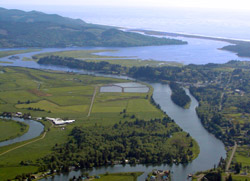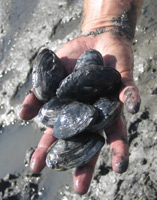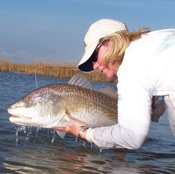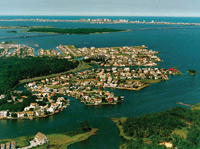What Two Ingredients Make Estuaries Suitable For Plants And Animals?
On this page:
- What Is an Estuary?
- Why Are Estuaries Important?
- How Are Estuaries Threatened?
What is an Estuary?
Video: What's an Estuary?
Runtime:5:17
An estuary is a partially enclosed, coastal water body where freshwater from rivers and streams mixes with salt water from the ocean. Estuaries, and their surrounding lands, are places of transition from land to sea. Although influenced by the tides, they are protected from the total force of body of water waves, winds and storms past land forms such as bulwark islands or peninsulas.

Estuarine environments are among the most productive on world, creating more organic affair each year than comparably-sized areas of woods, grassland or agricultural land. The sheltered waters of estuaries also back up unique communities of plants and animals specially adjusted for life at the margin of the sea.
Many unlike habitat types are institute in and around estuaries, including shallow open waters, freshwater and saltwater marshes, swamps, sandy beaches, mud and sand flats, rocky shores, oyster reefs, mangrove forests, river deltas, tidal pools and seagrass beds.
Why are Estuaries Important?

Estuaries provide united states with a suite of resources, benefits and services. Some of these tin can be measured in dollars and cents, while others cannot. Estuaries provide places for recreational activities, scientific study and aesthetic enjoyment. Estuaries are an irreplaceable natural resources that must be managed carefully for the mutual do good of all who savor and depend on them. Below are additional ways in which estuaries are of import (click to expand):
Estuaries Are Critical Natural Habitats
Thousands of species of birds, mammals, fish and other wildlife depend on estuarine habitats as places to live, feed and reproduce. And many marine organisms, including most commercially-important species of fish, depend on estuaries at some betoken during their development.
Because they are biologically productive, estuaries provide platonic areas for migratory birds to remainder and refuel during their long journeys. Because many species of fish and wildlife rely on the sheltered waters of estuaries as protected spawning places, estuaries are often called the "nurseries of the sea."
Estuaries Have Economic Value

Estuaries have important commercial value and their resource provide economical benefits for tourism, fisheries and recreational activities. The protected coastal waters of estuaries also back up of import public infrastructure, serving as harbors and ports vital for shipping and transportation.
The economy of many littoral areas is based primarily on the natural dazzler and compensation of estuaries. When those natural resources are imperiled, so too are the livelihoods of those who live and work in estuarine watersheds. Over one-half the U.South. population lives in coastal areas, including along the shores of estuaries. Littoral watershed counties provided 69 million jobs and contributed $7.nine trillion to the Gross Domestic Product in 2007 (National Ocean Economics Program, 2009).
Estuaries Perform Environmental Services
Estuaries also perform other valuable services. Water draining from uplands carries sediments, nutrients and other pollutants to estuaries. As the water flows through wetlands such as swamps and common salt marshes, much of the sediments and pollutants are filtered out. This filtration process creates cleaner and clearer h2o, which benefits both people and marine life.
Table salt marsh grasses and other estuarine plants also aid prevent erosion and stabilize shorelines.
Estuaries Human activity as Protective Buffers
Wetland plants and soils besides deed equally natural buffers between the land and ocean, absorbing alluvion waters and dissipating storm surges. This protects upland habitat as well as valuable real estate from storm and flood damage.
How are Estuaries Threatened?

Coastal counties are growing iii times faster than counties elsewhere in the nation. Unfortunately, this increasing concentration of people:
- upsets the natural residuum of estuarine ecosystems;
- threatens their integrity; and
- imposes increased pressures on vital natural resources like estuaries.
What happens on the land affects the quality of the h2o and health of the organisms that live in an estuary. For instance, if a river or stream flows through an agronomical area, it picks upward fertilizer, manure and pesticides from farming operations that run off the land after a rainstorm. Equally information technology passes urbanized and suburbanized areas, information technology gathers substances such as:
- fertilizers or pet waste that wash off lawns;
- untreated sewage from failing septic tanks;
- wastewater discharges from industrial facilities;
- sediment from construction sites; and
- runoff from impervious surfaces like parking lots.
Source: https://www.epa.gov/nep/basic-information-about-estuaries
Posted by: couturesaut1950.blogspot.com

0 Response to "What Two Ingredients Make Estuaries Suitable For Plants And Animals?"
Post a Comment